IN THIS ISSUE
- See a snake? No sweat
- Cottonmouth encounter
- Best plant for black swallowtails
- Questions trail endangered whales
- Loons or gulls: Which finds the fish
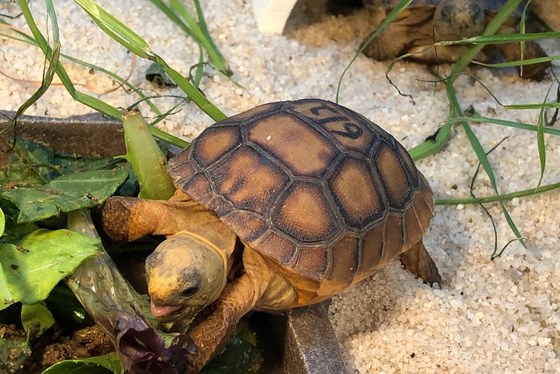 Young gopher feeding at Warm Springs (Jessica Radich/Warm Springs National Fish Hatchery)
Gopher tortoise 612 is getting a head-start thanks to conservation agencies and public support.
The Warm Springs National Fish Hatchery, where hatchling number 612 and scores of others are being raised for release into the wild, is part of an extensive effort to conserve gopher tortoises and keep them off the Endangered Species Act list in the eastern part of their range, which includes Georgia.
This effort will be explored in an upcoming newsletter. But for this issue, the emphasis is how to continue this work. Which mainly involves contributing to the Georgia Nongame Wildlife Conservation Fund.
This fund was created by state law to conserve native Georgia animals not legally fished for or hunted, plus rare native plants and natural habitats. DNR’s Wildlife Conservation Section depends on the fund. And the fund depends on you.
HOW TO HELP
Explore work done through the Nongame Wildlife Conservation Fund.
Top
 Scarlet kingsnake (John Jensen/DNR)
As spring settles in, snake sightings surge. So do snake questions fielded by DNR senior wildlife biologist John Jensen, co-author of “Amphibians and Reptiles of Georgia.”
But most calls involve only two questions: What species is it and what should I do?
First, Jensen says, chances are the snake you see is not a venomous species. Only six of the 46 snakes native to Georgia are venomous and only one – the copperhead – usually thrives where most Georgians live, in suburban areas.
“Although every county in the state is within the range of at least one venomous snake species, there is nowhere in the state that venomous species even come close to outnumbering non-venomous species.”
Jensen’s advice on what to do if you see a snake:
- Try to identify it from a distance. Here's a helpful resource.
- Do not try to handle the snake. Give it the space it needs.
- Remember that a) snakes eat rodents, insects and even other snakes; b) there is no need to fear non-venomous snakes; and, c) all of Georgia non-venomous species are protected by state law and one (eastern indigo) by federal law.
- If a clearly identified venomous snake is in an area where it represents a danger to people or pets, check georgiawildlife.com/nuisancewildlife to find a wildlife removal specialist in your area. Most snake bites occur when a snake is cornered or captured, and defending itself.
Don't want to see a snake? Lower the odds by removing brush, log piles and other habitat features that attract animals that snakes prey on, such as mice and lizards.
Yet also recognize that snakes are part of nature, often to the benefit of people. Some snakes eat rodents and even venomous snakes. Others prey on creatures considered pests. Brown and red-bellied snakes feed on snails and slugs. Southeastern and Florida crowned snakes primarily eat centipedes.
See a snake? Let it be.
Top
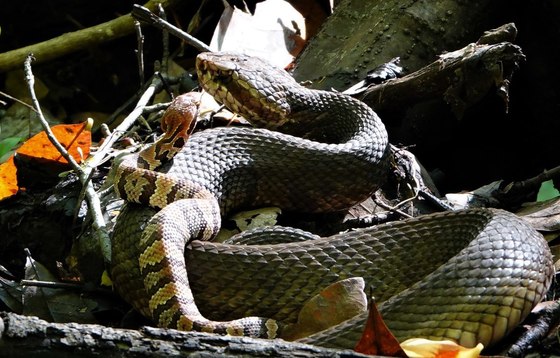 An adult and juvenile cottonmouth along a south Georgia stream (Matt Moore/DNR)
A common response to cottonmouths is fear. For Matt Moore, it’s curiosity.
Moore, who works with the Wildlife Conservation Section, considers cottonmouths the “most misunderstood and maligned” of Georgia’s venomous snake species (“Cottonmouth video undercuts myth,” May 25, 2017).
His interest led to a fascinating glimpse of “water moccasins” in the wild this week.
While wading a south Georgia stream, Moore spotted an adult cottonmouth he’d seen regularly since 2016 (he nicknamed her Blondie). He hid behind a cypress tree to avoid disturbing the snake, then used his camera's zoom for a closer look.
“At that point I saw the tiny juvenile cottonmouth, approximately 8 months old, laying on top of Blondie in the sunshine. It was a wonderful experience to see them basking together on a beautiful spring morning.”
Moore captured the snakes’ interaction is in this video.
As for the difference in their appearance, he explained that juvenile cottonmouths, like the young of many other Georgia snake species, typically have a vibrant color pattern that fades as they mature. The two cottonmouths he saw are an example of how much that color pattern can change as a snake becomes an adult.
FOR MORE
Download the DNR brochure "Is It a Water Moccasin?"
Top
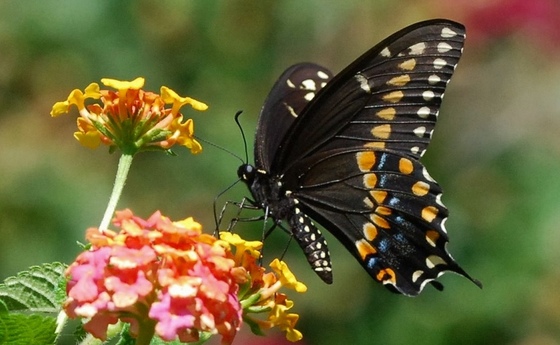 Male black swallowtail (Terry W. Johnson)
By TERRY W. JOHNSON
Seen in backyards across Georgia, the black swallowtail is stunning and big – one of the largest butterfly species that visits our yards.
But for homeowners who want to make sure they play host to black swallowtails, and even have the ideal opportunity to watch the life cycle of this butterfly without leaving their backyard, there’s a simple option: Plant bronze fennel.
Bronze fennel is a perennial herb that hails from the Mediterranean. It’s also one of the favorite host plants of black swallowtails. …
Read Terry’s column for details on bronze fennel, including planting tips.
Terry W. Johnson is a retired DNR program manager and executive director of TERN, the DNR Wildlife Conservation Section’s friends group. Read his columns, Backyard Wildlife Connection blog and book “A Journey of Discovery: Monroe County Outdoors.” (Permission is required to reprint this column.)
Top
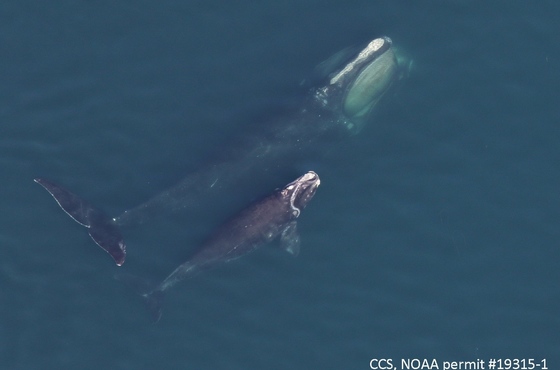 Right whale 1204 with her calf in Cape Cod Bay (Center for Coastal Studies/NOAA permit 19315-1)
The calving season for North Atlantic right whales ended last month on a glass-half-full or half-empty note.
Did the seven calves seen this winter off the Georgia/northeast Florida coast, the species’ only known calving grounds, signal the start of a comeback for one of Earth’s most imperiled whales?
Or are those seven – fewer than half the number needed to stabilize the population – only a blip in this bus-sized mammal’s slide toward extinction?
It will take a few years and a few more calving seasons to accurately assess how this winter fits into the right whale’s fate. But time for the species is running out, said DNR senior wildlife biologist Clay George, who monitors right whales.
“We can’t make more calves, but we can reduce the number of whales dying from human activities. And we need to do that quickly."
The 2018-2019 season obviously topped the previous winter, when no calves were seen, a first in more than 30 years of monitoring. However, 15-20 calves per year are needed for the species to simply break even. Meanwhile, the number of right whales has dropped the past five years from an estimate of about 475 to 425.
Why? Scientists point to unprecedented deaths from ship strikes and entanglement in fishing rope, primarily in New England and Canada, and sub-average calving since 2010. They also hypothesize that warming waters in the Gulf of Maine have moved zooplankton food resources north, resulting in leaner females and fewer pregnancies. Longer trips also increase exposure to ship traffic and fishing rope.
Another problem is the low number of calving females in the population. Already below 100, the estimated total could fall to 50 by mid-century if conditions don’t improve, according to researchers.
This season’s calf count will not be final until fall. The watch is on for "undocumented” calves in spring and summer on right whale feeding grounds in New England and Canada. The hope is some calves were missed in the Southeast. The partial government shutdown did ground some survey flights in January.
Two calves born in the Southeast this winter have been seen with their mothers off New England, confirmation the pairs survived the 1,000-mile migration north.
Another hopeful note: In 2018, Canada enacted sweeping shipping and fishing regulations following the death of 12 right whales in the Gulf of St. Lawrence in 2017. No stranded whales have been seen there since. Also, the Atlantic States Marine Fishery Commission has called for changes to lobster regulations to reduce entanglements in U.S. waters.
FOR MORE
Listen as Clay George describes DNR’s right whale work on GPB.
Top
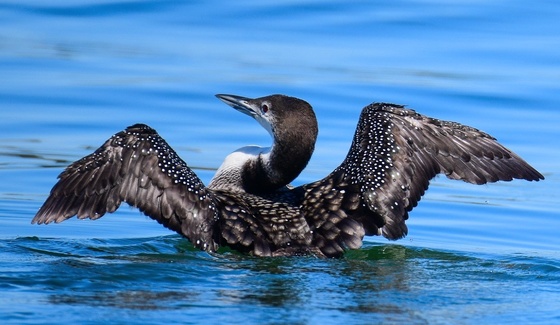 A common loon at Lake Lanier (Ron Goldfarb)
Welcome to Georgia Wild’s new feature that answers your wildlife questions.
After photographing common loons feeding on Lake Lanier last month, Ron Goldfarb raised a question about loons and gulls “fishing” together.
Do gulls clue in on loons because loons can snorkel, swimming with their eyes open in the water to spot fish? Goldfarb wrote. Or do loons take their lead from gulls, which find the fish first because of their aerial view?
The answer from Dr. Bob Sargent, a Wildlife Conservation Section program manager: Loons are at the front of the line.
“Gulls are well-known for their habit of stealing fish and other food items from other bird species, from each other and even from non-bird species,” Sargent wrote. “Gulls do not possess the morphological tools (e.g., a loon’s spear-like bill or an osprey’s long talons) found in loons, cormorants, grebes, terns, anhingas and ospreys that allow these other species to be far more adept at catching fish.
“Instead, like crows, gulls have adapted to a kleptoparasitic feeding strategy. Let the other guy do the work, then swoop in and harass him until you can steal a meal.”
Got a question about Georgia wildlife or conservation? Send it!
Top
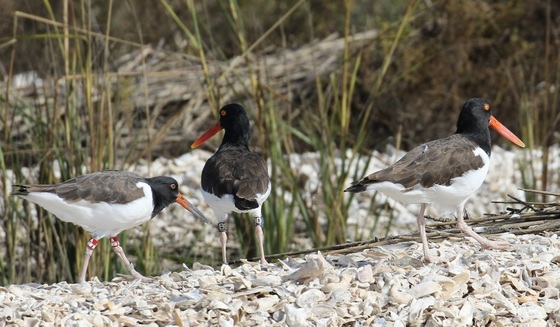 A family of American oystercatchers (Tim Keyes/DNR)
Raccoons and coyotes pose significant threats to shorebirds nesting on Georgia's beaches. But using National Fish and Wildlife Foundation funding, DNR has documented ways to limit the predators’ impact on two species of concern, Wilson’s plover and American oystercatcher. Shorebird research at a glance.
Among the study results, five of six oystercatcher nests on Cumberland Island fledged chicks, accounting for 11 percent of a record 61 oystercatchers fledged in Georgia last year. One chick was later seen in Nicaragua, part of a small but growing number of Atlantic-hatched oystercatchers showing up in Central America.
It’s a burning question: How does prescribed fire affect wild turkey nesting? The take-home, according to this Wildlife Resources Division blog post, is that while growing-season burns may destroy a small percentage of nests, benefits to turkey nesting and brood-rearing habitat easily outweigh the loss.

Video of pines bursting with pollen as DNR senior wildlife biologist Nathan Klaus flew past in a helicopter caused a social media stir. Shot during a prescribed burn at West Point Wildlife Management Area, the video drew 689,000 views on the Wildlife Resources Division's Facebook page and appeared on media outlets including CNN and USA Today. Which is nothing to sneeze at.
Four budding bird artists have been selected as T-shirt Art Contest winners in DNR’s 14th annual Youth Birding Competition. Selected from a record-setting 272 entries, the overall prize went to 11th-grader Kaichen Guo of Suwanee’s Lambert High for his eye-opening barn owl (right). See all winning artwork. The birding competition is April 26-27.
Also from metro Atlanta, Win Sheng, a 12-year-old who studies at First Fine Art and Design Studio in Johns Creek, won the 2019 Georgia Junior Duck Stamp Art Competition with a painting of a green-winged teal. “I painted the green-winged teal because of all the colors and its personality,” Sheng said.
Atlanta is a top 10 city in bird deaths from building collisions, a nationwide toll sized at 600 million birds a year. A Cornell Lab of Ornithology analysis of light pollution and radar measures of bird migration rated Chicago as the deadliest city for spring and fall migration, with Atlanta placing fourth and ninth, respectively.
Lights Out Atlanta is an Atlanta Audubon program encouraging building owners and homeowners to turn off or reduce lighting from midnight to dawn during peak migration periods, lessening the risk of bird/building strikes. Launched in 2017, almost 300 homeowners and 16 commercial properties have signed the pledge.
Top
|
 DNR's Pete Griffin discusses great horned owls at the festival (Paul Evans)
The 52nd annual Claxton Rattlesnake and Wildlife Festival attracted more than 15,000 people, and Wildlife Resources Division employees talked with hundreds of them about wildlife and conservation. Staff also provided outreach programs to two area elementary schools before the March festival.
If you see a tegu in the wild, particularly in Toombs or Tattnall County, take a photo, note the location and report it online, by phone (478-994-1438) or by email. DNR is investigating the possibility there is a population of invasive Argentine black and white tegus in the two south Georgia counties ("Lizard invaders," March 7).
Six wildlife-viewing projects from Pickens County to Jekyll Island have been announced as this year’s grant recipients by the DNR Wildlife Viewing Grants Program. Check out the projects and grants program.
Learn what passed, what didn’t and what the Georgia Conservancy sees as the pros and cons of key legislation during the 2019 General Assembly. The session’s last day was April 2.
Oconee County's Senior Center sports a Connect-to-Protect garden, thanks to Wildlife Conservation Section staff and Harper Ann Moffett, who helped lead the plant program in Oconee schools ("Teens promote plant connections," May 24).
Spring brings encounters with young and seemingly “orphaned” wildlife. But it is best to leave these animals alone: Often, a parent is nearby. For seriously injured animal, contact a licensed rehabilitator.
With bears also on the move, remember the No. 1 "bearwise" tip: Do not feed or approach bears. Both can be unsafe for bears and people. More at BearWise.org.
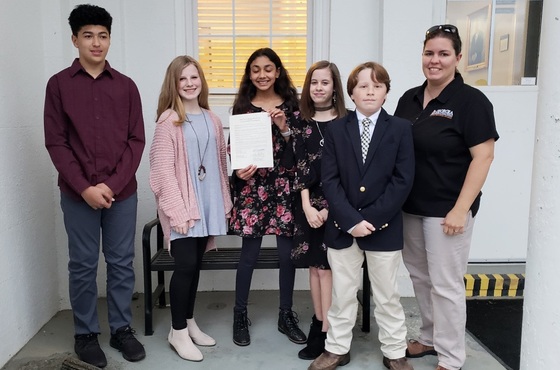 Lee County students promoting Gopher Tortoise Day with former DNR Program Manager Jessica McGuire
Lee County Middle School West students led a successful campaign to have county commissioners recognize April 10 as Gopher Tortoise Day in the southwest Georgia county. Gopher Tortoise Day is centered on raising awareness of gopher tortoises, Georgia’s state reptile, and their habitat.
Invasive plants took a hit in recent workdays including the Wildlife Conservation Section. One project removed sand pine at Townsend and big-leaf periwinkle on Altama Plantation wildlife management areas. A separate workday on Townsend focused on removing seedling sand pines near Radford’s mint.
Names in the news: DNR Capt. Ed Watkins retired last month after 18 years with the agency. Having flown helicopters for the U.S. Army, Air Force and Coast Guard, Watkins then spent "countless hours (flying) bald eagle, shorebird, manatee, right whale and sea turtle abundance surveys" for DNR, work critical to conserving protected wildlife species, the Georgia Sea Turtle Cooperative noted. Project WILD leaders presented the group’s Facilitator of the Year award to Stacey Britton and Kim Scasny of the University of West Georgia during the Environmental Education Alliance of Georgia banquet. The two were recognized for their dedication and hard work to introduce and train educators in Project WILD. Rena Peck Stricker is the Georgia River Network’s new executive director. The former contract ecologist with Coca-Cola will replace Dana Skelton, who will remain on staff and support the network’s programs and operations.
Top
UPCOMING
April 13-May 19 – 2019 Atlanta Bird Fest, Atlanta Audubon Society
April 15, 18 – Public hearings on Georgia 2019-2020, 2020-2021 hunting regulations: 7 p.m., April 15, Gainesville (Gainesville Civic Center and Forsyth (Monroe County Convention Center); April 18, Hagan (Evans County Wildlife Club)
April 22 – Earth Day (events in Atlanta). April 20 festival in Savannah.
April 23 -- Georgia Sea Turtle Conservation workshop and cooperators meeting, 8:30 a.m., Environmental Learning Center, DNR Coastal Headquarters, Brunswick
April 24-25 – Identification, mapping, control of invasive pests, UGA, Tifton
April 26-27 – Youth Birding Competition, banquet 5 p.m. April 27 at Charlie Elliott Wildlife Center, Mansfield
April 29 – Comment deadline for proposed changes to Georgia fishing regulations
May 3 – Wild for Georgia (Nature Conservancy), 7-11 p.m., Piedmont Park, Atlanta
May 18 – Keeping Georgia Wild Family Festival, Charlie Elliott Wildlife Center, Mansfield
WHAT YOU MISSED …
In the previous Georgia Wild:
- A unique tree few know about
- On the lookout for invasive lizards
- Fire that restores rare species, habitats
- Sampling for threatened trispot darters
Top
"Help Georgia wildlife; check the checkoff," Albany Herald (and others)
"Argentine black and white Tegus spotted in Toombs, Tattnall," WTOC-TV (Channel 11, Savannah). Also: Savannah Morning News, others via AP and UPI
"Georgia shorebird studies test ways to keep predators at bay," Savannah Morning News. Also: SaportaReport.
"Rattlesnake roundups: Southern tradition, ecological disaster," Popular Science
(paywall) "White fringeless orchid introduced to pocket wilderness," Chattanooga Times Free Press
"New grants promote wildlife viewing across state," The Summerville News
(+video) "Atlanta foundation fights to save frogs," WAGA-TV (Fox 5, Atlanta)
"Controlling the burn: Firefighters bring new life to forest," Rome News-Tribune
"State park employees recognized," Albany Herald
(+video) "NWF names Atlanta top 10 city for wildlife," WSB-TV (Channel 2, Atlanta), Georgia Wildlife Federation
"NSF awards grant for horseshoe crab 'ranch' in Georgia," EINPresswire
"Resurrecting the riverkeepers (freshwater mussels)," bioGraphic
"Filipino authorities find more than 1,500 smuggled turtles, tortoises," NPR
"Preparing for invasive pests before they arrive," Undark
"Scientists discover exotic new patterns of synchronization," Quanta Magazine
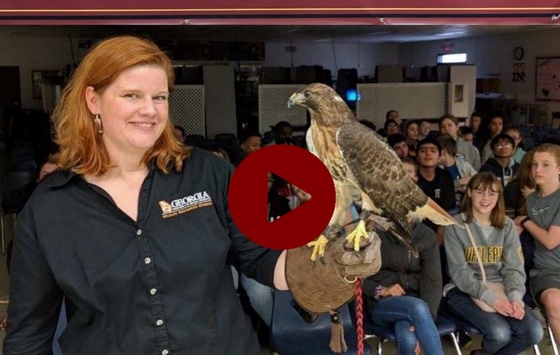 VIDEO
"The women of Georgia wildlife: Linda May," DNR. (Released as part of Women's History Month, the video received more than 4,000 views on Facebook.)
"Monroe County students focus on saving bats," Georgia Farm Monitor
"Dolphins strand feeding in Post Office Creek (Sapelo Island)," DNR
"Mythbusters: feral hog control," DNR
DNR's Nathan Klaus discusses prescribed fire at Tallulah Gorge, U.S. Forest Service
Ospreys ward off an intruder at Savannah nest, The Landings
Top
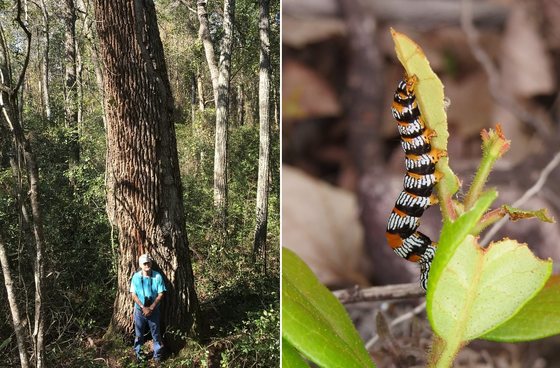 Alligator Creek finds: Frankie Snow with champ swamp tupelo; Okefenokee zale moth caterpillar
Alligator Creek Wildlife Management Area in Wheeler County is home to lots of interesting flora and fauna. Examples include Georgia’s largest swamp tupelo. Last fall, Frankie Snow of South Georgia State College submitted the nearly 110-foot-tall tree with a trunk more than 12 feet around and a 65-foot-wide crown to the Georgia Forestry Commission, which crowned it a state champion for Nyssa biflora. More recently, environmental consultant Dirk Stevenson reported an Okefenokee zale moth caterpillar on the 3,086-acre WMA. Known only from Florida, Georgia and South Carolina -- though mostly from the Okefenokee Swamp -- the bold patterned insect is imperiled globally and in Georgia. DNR acquired the Alligator Creek property with assistance from The Nature Conservancy and other partners in 2017. At the time, the tract near Lumber City ranked as a top five unprotected site for gopher tortoises in Georgia.
CREDITS
Masthead: Common loon on Lake Lanier (Rob Goldfarb)
Okefenokee zale moth caterpillar at Alligator Creek WMA (Dirk J. Stevenson)
Top
|